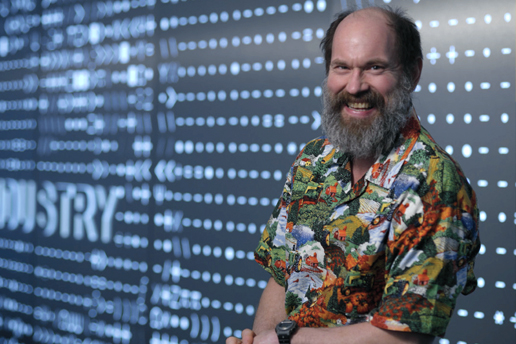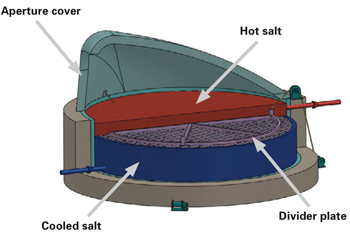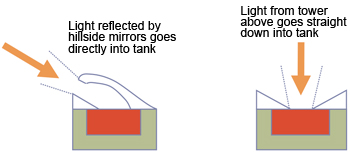
Overview
An MIT team has developed a novel system for capturing and storing the sun’s heat so it can be used to generate electricity whenever it’s needed. The new system is simple, durable, and inexpensive. Mirrors mounted on a hillside reflect sunlight directly into a large tank of molten salt, which absorbs the heat throughout its depth. The system can handle the intense power of the midday sun as well as temperature changes throughout the day and night without structural failure or interruptions in power production. Modeling studies and lab-scale experiments confirm the viability of the concept and the availability of extensive hilly areas suitable for installations. Teams from MIT and the Masdar Institute are now developing a pilot-scale version of the system that will soon be tested at a major experimental facility at Masdar.
Many commercial-scale plants now produce electricity using the heat of the sun—our most abundant renewable energy source. In one popular approach, large arrays of heliostats (sun-tracking mirrors) reflect sunlight to the top of a centrally located tower, where it’s focused on tubes carrying heat-absorbing fluid. The heated fluid is then pumped to a steam generator, where it converts water into steam that drives an electricity-generating turbine. But the tower is costly; the piping and pumps are expensive to install and run; and the intensely focused sunlight and the constant cycling between hot and cold challenge most materials. In addition, these “power towers” generally require a separate system to store heat to use when sunlight isn’t available.
To Alexander Slocum, the Pappalardo Professor of Mechanical Engineering, it seemed that there had to be a better way. Motivated by that belief, he and an interdisciplinary team of colleagues at MIT and the Masdar Institute in Abu Dhabi are now bringing a novel bench-scale system developed by the MIT participants to the next level of testing—at a large-scale experimental facility at Masdar. The system—called CSPonD, for “Concentrated Solar Power on Demand”—both captures and stores the sun’s thermal energy, for the most part utilizing known technological elements energetically combined in a new system architecture.
At the core of the CSPonD system is a large tank (illustrated below) that contains molten salt—a substance that can handle extremely high temperatures and has a huge capacity for absorbing heat. An array of heliostats is situated on a hillside, the tank of salt at the foot of the hill. The heliostats focus the sunlight through a small opening in the tank directly onto the surface of the salt (see second diagram below), where it penetrates the salt and is absorbed throughout its depth. Natural convection disperses the heat through the entire volume of molten salt. During power generation, hot salt is withdrawn from the top and passed through a steam generator; cold, but still molten, salt leaving the steam generator is returned to the bottom of the tank. A movable “divider plate” between the top and bottom regions maintains the upper volume of salt at a constant temperature. At night or when it’s cloudy, doors close to reduce heat loss.
CSPonD molten salt receiver/storage system

This diagram shows the large tank of molten salt that is central to the CSPonD system. Sun-tracking mirrors (heliostats) focus sunlight directly through the aperture at the left onto the surface of the salt. Hot salt is withdrawn from the top of the tank and passed through a steam generator for power production. The cooled (but still molten) salt is returned to the bottom of the tank. A movable divider plate at the center of the tank keeps the hot and cold salt separate. As salt is heated on a sunny day, the plate moves down in the tank to make room for more hot salt. When sunlight is unavailable, the plate moves up, making space for the cold salt coming from the steam generator. When the sun returns, the plate moves down, allowing cold salt to pass into the upper region for reheating. At night, the aperture cover is closed to prevent heat from escaping.
This arrangement provides a number of advantages. The sun’s energy encounters the working fluid directly— no tubes are needed—and the salt can reach 600°C or even 800°C, which is hot enough for highly efficient power production with either today’s most advanced steam systems or future ultra-efficient systems using supercritical carbon dioxide. Because heat is absorbed throughout the molten salt, temperature swings aren’t abrupt or extreme, so there’s no need to use costly materials that can tolerate all the energy the sun delivers at midday. “You can focus intense sunlight, and you’re not going to burn up the receiver because you can’t hurt the salt,” says Slocum. And the simple salts the team plans to use are well-known in industry. For the past century, companies worldwide have heat-treated steel by submerging it in large open vats of hot salt—similar to the CSPonD tank—and molten salt is regularly used as a heat-transfer fluid in industrial plants.
Finally, the new design can deal with deposits of dust and dirt. When a dust storm brews, the cover on the CSPonD tank can be closed. Any dirt that does land on the molten salt will sink to the bottom where it can be removed later during periodic cleanouts—just the way molten salt tanks are periodically cleaned in industry. Buildup of dust on the heliostat mirrors is still a concern, as with any solar energy system; but in the short term, the heliostat array can be oversized to ensure that production meets demand—even between cleanings. And unlike conventional systems, CSPonD can handle whatever sunlight is delivered when the mirrors are freshly cleaned and reflecting at full power. In the longer term, better self-cleaning surfaces are apt to be brought to market, especially if demand arises.
Designed for storage
Ensuring that the top layer of hot salt is always available for power production requires keeping the returning cold salt in its place—at the bottom of the tank. Most commercial heat-storage systems prevent mixing by using individual hot and cold tanks connected by hoses and pumps. But the CSPonD system separates hot and cold within the single tank.
A horizontal divider plate (shown in the first figure) is placed in the tank with a gap between its edge and the tank wall. Small actuators (with negligible power consumption) move the loose-fitting, mostly buoyant divider plate up and down to maintain the hot and cold salt volumes required for continuous operation. As sunlight heats the salt, the divider plate is lowered, and cold salt from below moves upward through the gap to be heated. Thus, at the end of a sunny day, the divider plate has moved down, and the hot salt region is fully charged. When sunlight is no longer available and heat is being extracted to produce electricity, the divider plate is slowly raised to allow the cold zone to refill while hot salt is supplied to the steam generator. When sunshine returns, the plate once again descends, allowing cold salt to rise for reheating. Careful control of the plate’s position ensures that the hot salt remains at a constant temperature, in effect balancing the solar energy input with the energy that’s extracted and stored.
Modeling results, experimental evidence
As an initial test of their concept, the researchers simulated the performance of a CSPonD system that included a tank that’s 5 meters deep, 25 meters in diameter, and filled with 4,500 tons (2,500 cubic meters) of molten salt at 600°C. The analysis concluded that the specified system could power a 4 megawatt-electric (MWe) steam turbine 24/7 (based on 7 hours of sunshine and 17 hours of storage)— enough electricity to supply about 2,000 homes. Modest oversizing of the heliostat field to accumulate more solar energy would enable the system to operate for an additional 24 hours (one cloudy day).
An economic analysis using a model from the National Renewable Energy Laboratory concluded that the levelized cost of electricity from the CSPonD system would be between $0.07 and $0.33 per kilowatt-hour. While the higher estimate is currently prohibitively high, the lower estimate would be competitive with the cost of electricity from conventional power sources today. Research now under way will help to better elucidate the actual costs.
The practical feasibility of CSPonD does, of course, hinge on the availability of appropriate hills for heliostat installations. How large would the hills need to be, and would suitable sites be hard to locate? To find out, researchers led by Alexander Mitsos, former assistant professor of mechanical engineering at MIT and now professor of chemical engineering at RWTH Aachen University in Germany, developed a novel algorithm that identifies potential sites using data on topography, solar insolation, and other conditions plus a model of CSPonD system operation.
They then performed two case studies focusing on government military bases at White Sands, New Mexico, and China Lake, California. The analyses showed that 15% of the total 10,000 square kilometers of land at the two bases would be appropriate for CSPonD installations. With 30% of that available land covered by heliostats, installations at each site could continuously generate 20 gigawatts of power. “So those two bases together could provide 40 gigawatts of power, which is somewhere around 4% of the nation’s electric need,” says Slocum. “And that’s just using a little piece of all the hillsides that they have.” Slocum adds: “The Army Corps of Engineers is responsible for our nation’s seacoasts and waterways to keep commerce flowing and protect our way of life at home, and it makes sense that vast government lands also be used to protect our energy security and combat climate change.”
While installing heliostats on hillsides isn’t standard procedure, Slocum isn’t concerned. “We may need to design and create custom equipment to drive up the sides of hills, popping in heliostats,” he says. “But companies have been designing amazing forestry machines that go up much steeper slopes for decades. It’s not an issue for the scale of systems that will be needed.”
Initial bench-scale experiments indicate that the CSPonD concept is technically sound. For example, in one set of tests, the researchers showed that concentrated sunlight will indeed penetrate and be absorbed by molten salt through a depth of 4 to 5 meters—enough for the CSPonD system to be unperturbed by changes in solar insolation due to passing clouds. In other tests, they designed and built a small-scale CSPonD tank equipped with a movable divider plate and then shone light from a high-flux solar simulator onto the molten salt inside. They found that natural convection in the upper region promotes mixing, keeping the top surface from overheating while maximizing thermal storage in a given volume of salt. And the submerged divider plate successfully separates the hot and cold salt volumes as needed for continuous operation.
CSPonD tank configurations

The researchers have designed two versions of the CSPonD tank suited to particular sites. Left: In this version, heliostats mounted on a hillside reflect sunlight into a tank below. The sunlight passes through the aperture in the tank directly onto the salt inside. Right: At Masdar’s experimental “beam-down” facility, mirrors on the central tower will reflect sunlight directly down through the aperture into the CSPonD tank.
Next steps
To test the CSPonD concept at larger scale, the MIT researchers have started work with colleagues at the Masdar Institute who operate a major experimental “beam-down facility” that includes 33 heliostats and a 66-foot tower with mirrors that reflect sunlight down into a central receiver. In upcoming work, the researchers will replace the receiver with a small CSPonD system. The heliostats will focus sunlight directly down into the tank (see the second diagram). The initial small-scale system will store enough thermal energy for 25 kilowatt-hours of power generation. “We’re going to use it to test our design theories and practical implementation issues,” says Slocum. “Then in the next step we can scale up to a much larger machine.”
Slocum stresses that he doesn’t dismiss other solar technologies and feels diversity is the key to robustness and continual innovation. Indeed, he praises photovoltaic and solar thermal systems “of various flavors” and notes in particular that everyone should at least have a rooftop solar hot water system. But CSPonD may be the best choice for certain locations and thus is a valuable addition to what Slocum calls a “well-balanced diet of options for feeding humanity’s ever-growing energy appetite.”
This research was supported in part by the Cyprus Research and Educational Foundation, the MIT Energy Initiative (MITEI) Seed Fund Program, and Lockheed Martin, a Sustaining Member of MITEI. Ongoing pilot-scale work is being funded in part by a cooperative agreement between the Masdar Institute of Science and Technology and MIT. Graduate student fellowships were provided by the S.D. Bechtel, Jr. Foundation, the Chesonis Family Foundation, and the Bill and Melinda Gates Foundation.
Other MIT participants in the CSPonD project are Professor Emilio Baglietto of nuclear science and engineering (NSE), Dr. Daniel S. Codd of mechanical engineering (ME), Dr. Charles W. Forsberg and Dr. Thomas J. McKrell of NSE, and Professor David L. Trumper of ME. Participants from the Masdar Institute include Professors Peter Armstrong and Nicolas Calvet, both of mechanical and materials engineering.
Further information can be found in the following:
D.S. Codd. Concentrated Solar Power on Demand. PhD thesis, MIT Department of Mechanical Engineering, June 2011.
D.S. Codd, A. Carlson, J. Rees, and A.H. Slocum. “A low cost high flux solar simulator.” Solar Energy, vol. 84, pp. 2202–2212, 2010.
A.H. Slocum, D.S. Codd, J. Buongiorno, C. Forsberg, T. McKrell, J.C. Nave, C.N. Papanicolas, A. Ghobeity, C.J. Noone, S. Passerini, F. Rojas, and A. Mitsos. “Concentrated solar power on demand.” Solar Energy, vol. 85, pp. 1519–1529, 2011.
This article appears in the Autumn 2014 issue of Energy Futures.